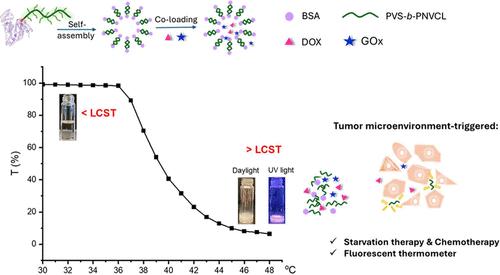多功能温敏脂质-蛋白质-聚合物共轭物:定制药物输送和生物成像
IF 8.2
2区 材料科学
Q1 MATERIALS SCIENCE, MULTIDISCIPLINARY
引用次数: 0
摘要
在这项研究中,我们介绍了一种由牛血清白蛋白(BSA)和脂基热共聚嵌段聚合物组成的蛋白质-聚合物生物共轭物。这些两亲性 BSA-聚合物共轭物可自主组织成囊泡,用于葡萄糖氧化酶(GOx)和多柔比星(DOX)的共传递,通过结合化疗-饥饿策略的协同癌症治疗,显示出高药物负载含量和显著的抗肿瘤活性。通过加入亲水性 BSA 嵌段,生物共轭物的较低临界溶液温度(LCST)被调至 40 °C左右,从而促进了对肿瘤细胞的靶向给药。因此,与传统的给药载体相比,这些智能蛋白质聚合物共轭物具有更大的前景,尤其是在抗癌治疗领域。此外,随着温度的升高,这些生物共轭物显示出更强的细胞内荧光强度,这归因于聚(乙烯基己内酰胺)(PNVCL)中非常规发色团分子的聚团触发发射。活跃的聚集诱导发射(AIE)特性和优异的生物相容性为进一步将这些生物共轭物应用于生物传感和细胞成像提供了机会。本文章由计算机程序翻译,如有差异,请以英文原文为准。

Multifunctional Temperature-Sensitive Lipid–Protein–Polymer Conjugates: Tailored Drug Delivery and Bioimaging
In this study, we introduce a protein–polymer bioconjugate comprising bovine serum albumin (BSA) and a lipid-based thermoresponsive block copolymer. These amphiphilic BSA-polymer conjugates can autonomously be organized into vesicular compartments for codelivery of glucose oxidase (GOx) and doxorubicin (DOX), demonstrating high drug loading content and remarkable antitumor activity via synergistic cancer therapy combining chemo-starvation strategies. Through the incorporation of a hydrophilic BSA block, the lower critical solution temperature (LCST) of the bioconjugates is tuned to around 40 °C, facilitating their targeted drug delivery to tumor cells. Consequently, these smart protein–polymer conjugates present greater promise compared to traditional drug delivery vehicles, particularly in the realm of anticancer therapy. Moreover, these bioconjugates displayed enhanced intracellular fluorescence intensity with increasing temperature, attributed to the clustering-triggered emission of the nonconventional chromophore moieties within poly(vinylcaprolactam) (PNVCL). The active aggregation-induced emission (AIE) characteristic and excellent biocompatibility suggest an opportunity to further apply these bioconjugates for biosensing and cellular imaging.
求助全文
通过发布文献求助,成功后即可免费获取论文全文。
去求助
来源期刊

ACS Applied Materials & Interfaces
工程技术-材料科学:综合
CiteScore
16.00
自引率
6.30%
发文量
4978
审稿时长
1.8 months
期刊介绍:
ACS Applied Materials & Interfaces is a leading interdisciplinary journal that brings together chemists, engineers, physicists, and biologists to explore the development and utilization of newly-discovered materials and interfacial processes for specific applications. Our journal has experienced remarkable growth since its establishment in 2009, both in terms of the number of articles published and the impact of the research showcased. We are proud to foster a truly global community, with the majority of published articles originating from outside the United States, reflecting the rapid growth of applied research worldwide.
 求助内容:
求助内容: 应助结果提醒方式:
应助结果提醒方式:


